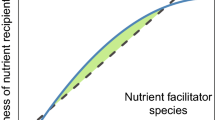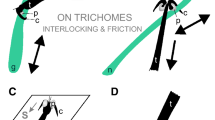Abstract
Positive species interactions tend to be context dependent. However, it is difficult to predict how benefit in a mutualism changes in response to changing contexts. Nepenthes pitcher plants trap animal prey using leaf pitfall traps known as pitchers. Many specialized inquiline organisms inhibit these pitchers, and are known to facilitate the digestion of prey carcasses in them. Nepenthes gracilis traps diverse arthropod prey taxa, which are likely to differ greatly in the ease with which they may be digested, independently of inquilines, by plant enzymes. In this study, we used in vitro experiments to compare the nutritional benefit provided by phorid (scuttle fly) and culicid (mosquito) dipteran larvae to their host, N. gracilis, and to each other. The effects of phorids on N. gracilis nutrient sequestration were very variable, being positive for large prey which have low digestibility, but negative for small prey which are highly digestible. However, the effect of culicids on N. gracilis and the effects of culicids and phorids on each other were not significantly altered by prey type. These results show that a digestive mutualism is highly dependent on the digestibility of the resource—a context dependency that conforms well to the predictions of the stress–gradient hypothesis in facilitation research. Our findings have significant implications for many other digestive mutualisms, and also suggest that greater insights may be gained from the synthesis of concepts between the fields of mutualism and facilitation research.



Similar content being viewed by others
References
Anderson B, Midgley JJ (2013) Digestive Mutualism, an alternate pathway in plant carnivory. Oikos 102:221–224. https://doi.org/10.1034/j.1600-0706.2003.12478.x
Athauda SB, Matsumoto K, Rajapakshe S, Kuribayashi M, Kojima M, Kubomura-Yoshida N, Iwamatsu A, Shibata C, Inoue H, Takahashi K (2004) Enzymic and structural characterization of nepenthesin, a unique member of a novel subfamily of aspartic proteinases. Biochem J 381:295–306
Bäckhed F, Ley RE, Sonnenburg JL et al (2005) Host-bacterial mutualism in the human intestine. Science 307:1915–1920. https://doi.org/10.1126/science.1104816 (80-)
Bartoń K (2016) MuMIn: multi-model inference. R package version 1.40.0. https://CRAN.R-project.org/package=MuMIn
Bates D, Mächler M, Bolker B, Walker S (2015) Fitting linear mixed-effects models using lme4. J Stat Softw 67:1–48. https://doi.org/10.18637/jss.v067.i01
Beaver RA (1979) Biological studies of the fauna of pitcher plants (Nepenthes) in west Malaysia. Ann la Soc Entomol Fr 15:3–17
Bertness MD, Callaway R (1994) Positive interactions in communities. Trends Ecol Evol 9:187–191. https://doi.org/10.1016/0169-5347(94)90087-6
Bronstein JL (1994) Conditional outcomes in mutulistic interactions. Trends Ecol Evol 9:214–217
Bronstein JL (2009) The evolution of facilitation and mutualism. J Ecol 97:1160–1170. https://doi.org/10.1111/j.1365-2745.2009.01566.x
Brune A, Ohkuma M (2010) Role of the termite gut microbiota in symbiotic digestion. In: Bignell DE, Roisin Y, Lo N (eds) Biology of termites: a modern synthesis. Springer, Dordrecht, pp 439–475
Bruno JF, Stachowicz JJ, Bertness MD (2003) Inclusion of facilitation into ecological theory. Trends Ecol Evol 18:119–125
Burnham KP, Anderson DR (2002) Model selection and multimodel inference: a practical information-theoretic approach. Springer, Berlin
Chamberlain SA, Bronstein JL, Rudgers JA (2014) How context dependent are species interactions? Ecol Lett 17:881–890. https://doi.org/10.1111/ele.12279
Choo JPS, Koh TL, Ng PKL (1997) Pitcher fluid macrofauna: nematodes and arthropods. In: Tan HTW (ed) A guide to the carnivorous plants of Singapore. Singapore Science Centre, Singapore, pp 141–154
Fugère V, Andino P, Espinosa R et al (2012) Testing the stress-gradient hypothesis with aquatic detritivorous invertebrates: insights for biodiversity-ecosystem functioning research. J Anim Ecol 81:1259–1267. https://doi.org/10.1111/j.1365-2656.2012.01994.x
Gaume L, Bazile V, Huguin M, Bonhomme V (2016) Different pitcher shapes and trapping syndromes explain resource partitioning in Nepenthes species. Ecol Evol 6:1378–1392. https://doi.org/10.1002/ece3.1920
Hammond JB, Kruger NJ (1988) The bradford method for protein quantitation. New Protein Techniques. Humana Press, New York, pp 25–32
Heard SB (1994) Processing chain ecology: resource condition and interspecific interactions. J Anim Ecol 63:451. https://doi.org/10.2307/5562
Hoeksema JD, Bruna EM (2015) Context-dependent outcomes of mutualistic interactions. Mutualism. Oxford University Press, Oxford, pp 181–202
Hu Y, Sanders JG, Łukasik P et al (2018) Herbivorous turtle ants obtain essential nutrients from a conserved nitrogen-recycling gut microbiome. Nat Commun. https://doi.org/10.1038/s41467-018-03357-y
Lam WN, Chong KY, Anand GS, Tan HTW (2017) Dipteran larvae and microbes facilitate nutrient sequestration in the Nepenthes gracilis pitcher plant host. Biol Lett 13:20160928. https://doi.org/10.1098/rsbl.2016.0928
Lam WN, Wang WY, Cheong LF et al (2018) Pitcher plant facilitates prey capture in a sympatric congener. Plant Ecol 219:299–311. https://doi.org/10.1007/s11258-018-0796-4
Maestre FT, Callaway RM, Valladares F, Lortie CJ (2009) Refining the stress-gradient hypothesis for competition and facilitation in plant communities. J Ecol 97:199–205. https://doi.org/10.1111/j.1365-2745.2008.01476.x
Moran J, Booth W, Charles J (1999) Aspects of pitcher morphology and spectral characteristics of six Bornean Nepenthes pitcher plant species: implications for prey capture. Ann Bot 83:521–528. https://doi.org/10.1006/anbo.1999.0857
R Core Team (2017) R: a language and environment for statistical computing. R Foundation for Statistical Computing, Vienna
Russell JA, Moreau CS, Goldman-Huertas B, Fujiwara M, Lohman DJ, Pierce NE (2009) Bacterial gut symbionts are tightly linked with the evolution of herbivory in ants. Proc Natl Acad Sci USA 106:21236–21241
Sanders JG, Lukasik P, Frederickson ME et al (2017) Dramatic differences in gut bacterial densities correlate with diet and habitat in rainforest ants. Integr Comp Biol 57:705–722. https://doi.org/10.1093/icb/icx088
Therneau TM (2018) coxme: mixed effects cox models. R package version 2.2-7. https://CRAN.R-project.org/package=coxme
Thrall PH, Hochberg ME, Burdon JJ, Bever JD (2007) Coevolution of symbiotic mutualists and parasites in a community context. Trends Ecol Evol 22:120–126
Acknowledgements
We thank Sherry Hung for advice with statistical analysis, as well as Antonia Monteiro and Liew Chye Fong for the provision of various items of laboratory equipment that were essential to the conduct of the study.
Author information
Authors and Affiliations
Contributions
FWSL, WNL, and HTWT composed the study design. FWSL and WNL collected specimens. FWSL conducted the experiments, collected the data, and performed the analysis. WNL wrote the first manuscript draft and all other authors contributed to revisions, approved the final version of the manuscript, and agreed to be held accountable for all aspects of the work presented here
Corresponding author
Ethics declarations
Conflict of interests
We declare that we have no competing interests.
Data accessibility
We intend to deposit data associated with this manuscript in Figshare. Data accessibility Data associated with this article is available at https://doi.org/10.6084/m9.figshare.7064486.v2
Additional information
Communicated by Joel Sachs.
Electronic supplementary material
Below is the link to the electronic supplementary material.
Rights and permissions
About this article
Cite this article
Leong, F.W.S., Lam, W.N. & Tan, H.T.W. A dipteran larva–pitcher plant digestive mutualism is dependent on prey resource digestibility. Oecologia 188, 813–820 (2018). https://doi.org/10.1007/s00442-018-4258-4
Received:
Accepted:
Published:
Issue Date:
DOI: https://doi.org/10.1007/s00442-018-4258-4




